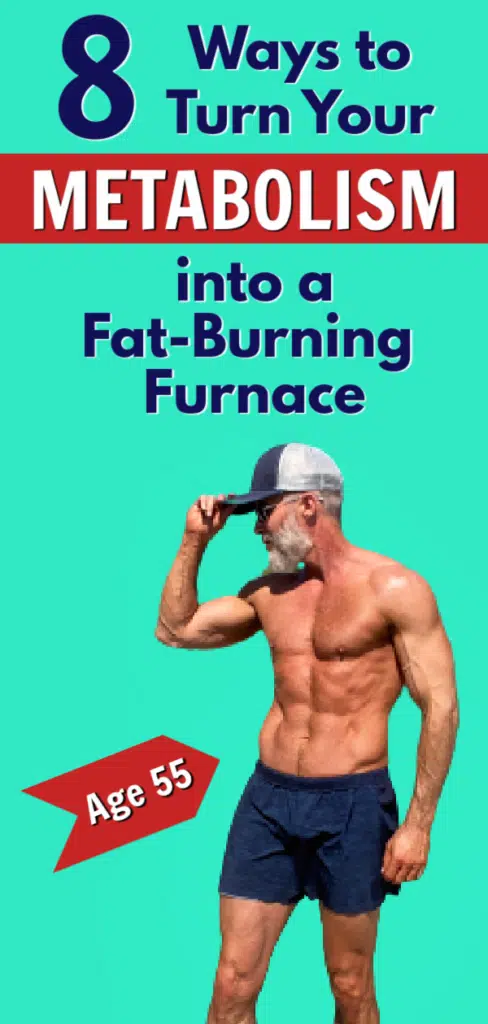Is your metabolism a fat-burning furnace?
You want the food you eat to burn as energy instead of being stored as a fat cell, and a healthy and robust metabolism will accomplish this.
- Some people have metabolisms that can be sluggish.
- While other people’s metabolisms operate more efficiently.
The information and the video of metabolic-boosting exercises below will prove helpful for improving your body composition.
Is Your Metabolism Operating Optimally?
Some factors that help to regulate metabolism are beyond your control – such as age, genetics, and gender.
However, other metabolic factors are within your control, such as muscle-to-fat ratio and the overall health of your body.
The more muscle you have, the more calories you burn. The healthier you are, the more efficiently your body’s systems regulate; metabolism is no exception.
A healthy metabolism is like a calorie-burning furnace.
It’s much easier to keep stoking the flames of that furnace with occasional firewood than to let the fire die out completely – and then have to spend extra time to build and relight the fire from scratch.
Here are eight ways to improve the efficiency and health of your metabolic system so that it uses your own fat cells for energy.

1. Eat Before You Become Ravenous
Within the recovery community is a popular saying: “never let yourself get too hungry, angry, lonely, or tired.” As humans, these feelings can lead us toward bingeing behaviors in an attempt to self-medicate discomfort or anxiety.
Many people benefit by keeping their blood sugar consistent at healthy levels throughout the day. This runs contrary to that old saying “eat only when you’re hungry” – which for many people is terrible advice.
Eating only when hungry can wreak havoc on a person’s metabolism by creating dramatic swings between feeling stuffed and feeling ravenous.
I realize this is counterintuitive. Our logical minds tell us that to let ourselves become hungry must therefore mean we are burning fat cells.
This is not always so. Metabolism hates swings.
2. Create a More Efficient System for Weekly Meal Planning and Preparation
Should you eat one big meal each day, or the standard three?
Is eating six smaller meals throughout the day better?
The answer to these questions is: whatever helps you eat healthier.
For me, I do six a day.
I was resistant to this idea in the beginning. Having six smaller meals throughout the day just seemed like more work than having three big meals (for starters, I didn’t want to brush my teeth six times a day). Also, I know very fit people who only eat once or twice a day.
However, eventually, I had to admit it: 6 smaller meals (even though it adds up to the same amount of daily calories) kept me leaner and stronger than 3 bigger meals (and if I’m on the road, I can chew a piece of natural gum after, to help keep my teeth clean).

The other advantage to 6-small over 3-big is that most people don’t need over 800 calories in one sitting.
Anything over 800 calories in one-fell-swoop risks converting to fat cells (for some people – depending on their size, age and muscle ratio – that might be as low as 600 calories).
This is controversial. In vogue currently, intermittent fasting allows one to eat just one or two giant meals daily. Many people swear by this.
If it works for you, I support it. I’ve tried intermittent fasting several times, but I just haven’t been able to personally pull this off in a way that feels healthy. My friends who do it succeed at it – partly, by drinking a lot of black coffee throughout the day.
To give my body a break from digesting food and all the work that involves, I refrain from eating anything for 12 hours each night, usually between 7:30 pm and 7:30 am.
But that’s what’s working for me now personally. It’s different for each person, and I haven’t seen any convincing research yet that one system is collectively better for everyone.
What matters most, in my opinion, is that you plan your eating so that you can eat as healthy as possible.
I’m not a big fan of “winging it,” as I notice that people with no system for weekly menu planning often make unfortunate choices when they become busy and hungry.

3. Identify Your Macros
You can develop the vital skill of looking down at a plate of food and quickly identifying the macronutrients.
Macronutrients (“macros” as nutritionists and athletes are keen to say) are substances required in relatively large amounts by living organisms – in this case, they are the fats, proteins, and carbohydrates essential to the human diet.
Different foods’ effects on blood sugar levels vary considerably. Foods with simpler carbohydrates break down quickly during digestion and tend to “spike” glucose levels. In contrast, foods with more complex carbohydrates will break down slower and gradually release glucose into the bloodstream.
It’s generally a good idea to avoid spikes, which is why complex carbs are usually better than simple carbs, and healthier fats are sometimes better than carbs or excess protein.

Kids didn’t use to get fatty liver disease and type 2 diabetes, but today doctors see a rise in children with metabolic syndrome.
Researchers found “that within ten days of going off sugar, there was a dramatic improvement in the health of these children.
And the kids didn’t even eat fewer calories or lose weight. The only thing they did was eat other calories instead of calories from sugar (see Sources below this article).
Throughout today – as you eat or drink – I encourage you to identify what ingredients in your food are carbohydrates, fats, or proteins.
4. Eat Way More Vegetables
Speaking of complex carbohydrates, the best from this macro category are vegetables.
To reach new health, fitness, and weight-loss goals, most people will find that they need to increase their daily intake of fresh vegetables.
I solved the vegetable dilemma in my daily diet by often having:
- a freshly made green smoothie for breakfast
- fresh veggie sticks with lunch (recipe in #8 below)
- a “super salad” for dinner
Whether you want to lose belly fat, improve your body’s disease prevention, grow more “thin” gut microbes within your digestive system, or have more sustained energy throughout the day for your workouts – any of these goals will eventually require an uptake in vegetables.

5. Track Your Hydration on Behalf of Your Metabolism
Hydration has a proven impact on metabolic function.
A few times a year, it’s an excellent idea to periodically track your hydration. This involves carefully counting how many ounces of pure water (not coffee, tea, juice – just pure water) you consume on a typical day.
I’ve found that nearly everyone underestimates the amount of water they drink, and proper habitual hydration makes a big difference in a person’s overall wellness.
Being even a little dehydrated can negatively impact your metabolism and even your immune system (many people make themselves vulnerable to cold and flu viruses by allowing themselves to become dehydrated – usually without realizing it).
The good news is that hydrating is one of the most straightforward self-care protocols.
By simply listening more carefully to your body’s own nuanced signals, you’ll be motivated to remember to drink your water.

For example, you know those days when you slept about 8 hours but still feel a bit tired around 2 pm? Often, this is a dehydration signal. Simply drink a tall glass of pure water and see if you don’t feel better almost instantly.
Additionally, when we think we are hungry, sometimes we’re really just feeling a bit dehydrated. A glass of water will make the “hunger” disappear (if your mouth feels dry and thirsty, that can mean that you’re already way past the point of being a bit dehydrated and further on your way to full-blown dehydration).
Today, I invite you to track your water intake. Use one of the water calculators online to determine your goal. You may want to raise the number a bit if you plan on exercising.
Some people find it helpful to put the measured water, all at once, into one large container and then keep it with them throughout the day, gradually drinking from it between meals and snacks.
6. Ask, “If I Were to Sabotage My Metabolism, How Would I Do It?”
If you remember nothing else from this article, I hope you’ll remember this: preparation = success.
In earlier articles, I have touched on the immense importance of preparation – how preparation is the most skipped stage of change. And therefore, the primary reason that most people fail to create new good daily habits that last.
How can you best prepare for beginning a new, positive habit within your weekly life, such as improving the way your own body’s metabolism functions?
An excellent place to start is to ask yourself: “if I were to get in my own way, how would I do it?” (The video near the end of this article explains.)
Nobody knows you better than you do how you might unintentionally self-sabotage, so your first gut-instinct answer to that question is usually the correct one.
In the video below, I explain how the solutions become much easier to identify once you know in what specific ways you might be tempted to sabotage yourself.
7. Move into Action on Behalf of Your Metabolism
Now that you have a plan to improve your metabolism, you can begin implementing it.
As I mentioned earlier, many of us run into trouble when we get tired and hungry. That tends to be when we derail, so it’s a good idea to prevent yourself from getting exhausted or ravenous anytime during any day.
Going through your typical day in your head, you can already see a few points during the day when you might get into trouble. Such as: not going to bed early enough the night before – means you’re sleep-deprived – grumpier and foggier – the following day. This means you would likely make poorer, more impulsive food choices.
Think that through a bit more, do a little math, and you can figure out the ideal time each night to turn off the lights.
Notice that the whole thought process I just laid out only took you a few minutes. The preparation stage can sometimes be very easy, and yet, it’s essential that it not be skipped.
You might next pause to consider when – on a typical day – you forget to eat until it’s too late (and then you’re famished and in the “danger zone” for bad snacking).
You do a bit of math and decide that at such-and-such a time, you need to have approximately such-and-such calories to tide you over until proper mealtime.
But logistically, you realize that you’ll be too busy to make something healthful to eat then, so you’ll need to bring something with you each day – but then you realize that your weekday mornings are overextended as it is, so when will you make the healthy snack?
You decide that on Saturday afternoons, you will clean and chop organic veggies (celery, carrots, red bell pepper, cucumber, maybe even a purple turnip or two) and put them in baggies or Tupperware in the refrigerator as crunchy snacks for the week ahead.
These preparation strategies might be all that’s required to move briskly toward success and achieve your new health goal of improved metabolism.
It doesn’t matter what the goal is or your specific strategy for avoiding self-sabotage. The more significant point here is that whatever your goal, good preparation will help you to achieve it better.
8. Try the Metabolism-Boosting Workout
Each time in my life that I have managed to create washboard abdominals, it’s because I added Higher-Intensity Interval Training (HIIT) to my exercise regimen. HIIT really works.
I recommend you do a HIIT session at least once each week:
- The bad news is that it’s challenging and makes you sweat (which I enjoy personally, but I know not everyone does).
- The good news is that it doesn’t take long.
We’re not entirely sure why HIIT is more effective at burning fat than other physical activities.
Some believe that increased oxygen consumption improves post-exercise metabolism. Whatever the reason, you might want to experiment with HIIT to see if it works for you.
In a HIIT workout, you alternate sprint-type intervals with rest intervals – but make sure you warm up carefully beforehand.
In the video lower within this article, I provide a specific version of HIIT, The Metabolism-Boosting Workout. It’s a series of circuits that must be completed 3 times before moving on to the next circuit (each circuit has several consecutive exercises within it).
When you finish all the exercises within a circuit, take a rest period before repeating the circuit (or moving on to the next circuit if that was your third time through):
- Advanced athletes do 14 reps per exercise and take 30-seconds during rest periods.
- Intermediate-level athletes do 10 reps per exercise and take a full minute during rest periods.
- Beginners do 8 reps per exercise and take 2 minutes during rest periods.
This workout intentionally utilizes compound movements.
The big idea behind compound movements is that they can help boost your metabolism because they engage significantly more muscles than isolation lifts – and burn way more calories.
There is a theory that compound movements – squats and pull-ups, for example – are more fundamentally primal and therefore signal the body that its metabolism will need to rev up to meet the needs of a highly active and natural lifestyle.
Imagine our ancestors climbing trees, lifting boulders, and hoisting bison or deer up over their shoulders. Compound exercise movements often mimic these primal activities.
The workout takes less than an hour. As always, ask your medical doctor before implementing a new exercise regimen or substantial lifestyle change.
Of course, if you feel joint pain or dizziness, stop at once. Beginners can make any modifications necessary (for instance, using a lighter weight or doing fewer reps). For pull-ups, beginners might find it helpful to use an assistance band or do jump-up pull-ups instead.
Circuit 1 (Warm-Up):
- Ab Wheel
- Overhead Barbell Side-to-Side Leans
Circuit 2:
- Dips
- Front Kettlebell Squat
- Chin-Ups
Circuit 3:
- Straight-Line Push Ups (Using Ball and Bench)
- Overhead Dumbbell Squat
- Wide-Grip Pull-Ups
Circuit 4:
- Bench Dips (Using Ball and Bench)
- Bulgarian Dumbbell Split Squat
- Reverse-Grip Pull-Ups
Be mindful of your form and breathing while doing each exercise. Seemingly little corrections can make a big difference. For example:
- avoid holding your breath
- avoid hyper-extending (locking) your knee joints
- keep your core muscles active (navel pulled in)
- keep your pelvis centered
- keep your torso tall, your spine long, and your shoulders down and centered
- avoid rolling your body weight to one side of your foot – keep all four corners of your feet firmly grounded.

During my decades as a fitness trainer and wellness coach, I’ve recognized behavior patterns that benefit metabolism.
But these are my opinions.
Everybody is different, and I encourage you to consult with your medical doctor, nutritionist, or naturopath to discover what lifestyle improvements might make the most difference in improving your own metabolism.
You can strengthen your metabolism for better fat-cell energy utilization.
Resting metabolic rate is a phrase that refers to your ability to burn more calories even while at rest. The more muscle tissue you possess, the higher your resting metabolic rate will be. The above tips can help you get there.
Additional Sources about Metabolism:
“research determines higher-fat/lower-carb intake impacts post-exercise energy metabolism – is associated with greater post-exercise resting energy-expenditure, indicating greater fat utilization” http://bayesianbodybuilding.com/carbs-vs-fat-research-update/

“water, hydration and health” http://www.ncbi.nlm.nih.gov/pmc/articles/PMC2908954/
“potential for high-intensity interval training to reduce cardiometabolic disease risk” http://www.ncbi.nlm.nih.gov/pubmed/22587821
“new metabolism study” Varda Epstein: http://www.kars4kids.org/blog/sugar-harms-a-childs-metabolism-says-new-study/

đăng ký email mới
Friday 3rd of July 2020
đăng ký email mới
Strengthen Your Metabolism for Fat-Cell Energy Utilization
dấu hiệu nhiễm trùng sau khi nâng mũi
Friday 3rd of July 2020
dấu hiệu nhiễm trùng sau khi nâng mũi
Strengthen Your Metabolism for Fat-Cell Energy Utilization
Leg Day: A Lower-Body, Functional-Training Workout • Over Fifty and Fit
Saturday 4th of January 2020
[…] can increase protein synthesis and the body’s metabolic rate. These responses play a pivotal role in tissue healing, remodeling, and […]
Mat Exercise Program for Strength and Flexibility – A No-Gym Workout
Monday 12th of August 2019
[…] without stopping – your heart rate remains accelerated, in the zone appropriate for utilizing fat cells for energy. Calories will be […]
16 Battle Rope Exercises for a Lean, Powerful Body • Over Fifty and Fit
Sunday 7th of July 2019
[…] that you’re breathing very heavily. This is your indication that you’re burning your body’s fat stores for […]